For the Policy Community
Civil resistance movements have a proven role in advancing human rights, promoting democratic governance, and curtailing corruption. They are a critical factor addressing root causes of human suffering, reducing deadly violence in the world and contribute to peacebuilding. They can also help deter coups d’état.
It is incumbent for members of the policy community—whether in international nongovernmental organizations (INGOs), think tanks, multilateral institutions, or governments—who care about these issues to understand how movements work; their historic record of making change; and when, how, and under what circumstances external actors can take actions that are helpful to movements.
 This can be challenging to external actors, because civil resistance movements are different than traditional hierarchical organizations. Movements are also disruptive—they upset existing power arrangements. They are driven by popular energy and initiative, and external actors can neither start movements nor control them.
This can be challenging to external actors, because civil resistance movements are different than traditional hierarchical organizations. Movements are also disruptive—they upset existing power arrangements. They are driven by popular energy and initiative, and external actors can neither start movements nor control them.
However, external actors can play an important role in expanding the political space within different societies, inhibiting the capacities and actions of repressive adversaries, and responding to the needs that movements express. The actions of sympathetic external actors can be seen as an extension of what a movement demands.
ICNC supports research, informed discussions, and the development of resources about effective external assistance to nonviolent movements and campaigns. It is particularly important for members of the policy community to address this issue at a time of increasing repression against civil resisters and civil society around the world.
ICNC Special Report Series
Launched in 2017, ICNC’s Special Report Series aims to bridge the gap between academic, policy and other practitioner communities. ICNC Special Reports draw on cutting-edge research to show the intersection of civil resistance and other fields such as peacebuilding, conflict resolution and international development.
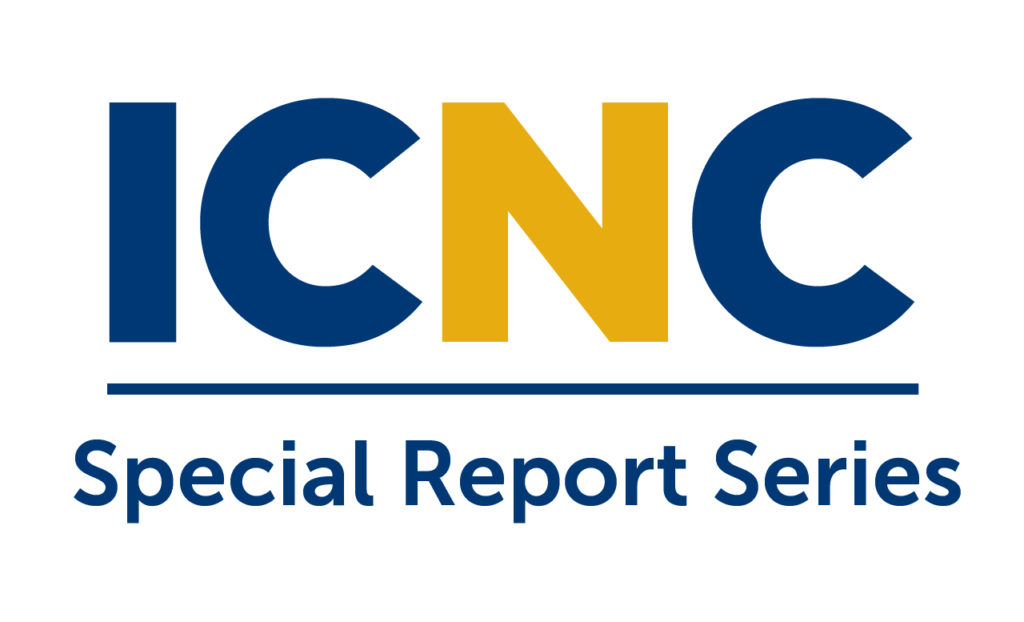
How to Win Well: Civil Resistance Breakthroughs and the Path to Democracy
By: Jonathan Pinckney
Date of Publication: April 2021
Free Download | Purchase a Print Copy
How do nonviolent resistance movements oust dictators? What effects do these different ways of ousting dictators have on countries’ long-term political trajectories? In this special report, I trace the pathways through which civil resistance movements of the last seventy years have removed dictatorships and the impact of these different pathways on levels of democratic progress. I find that pathways that involve campaign initiative, institutional mechanisms, and building cooperative norms – particularly negotiated transitions – tend to lead to the highest levels of democratic progress.
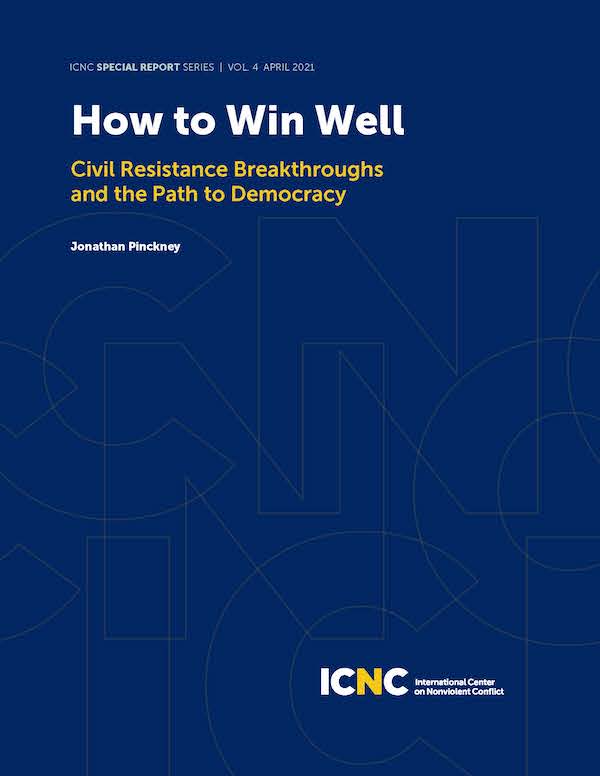
Sudan’s 2019 Revolution: The Power of Civil Resistance
By: Dr. Stephen Zunes
Date of Publication: April 2021
Free Download | Purchase a Copy
The Sudanese revolution began in December 2018 with a series of strikes, protests, and other acts of civil resistance taking place throughout the country. In February 2019, dictatorial president Omar al-Bashir declared a state of emergency and dissolved the national and regional governments, strengthening direct rule by military and intelligence officers. Massive protests resumed in early April and the military staged a coup, removing al-Bashir from power after a 30-year rule and assuming power as the Transitional Military Council. Pro-democracy activists demanded they turn over power to a civilian-led interim government with protests, along with negotiations, continued. On June 3, security forces massacred 128 people and detained and abused hundreds of detainees. Pro-democracy groups responded with a general strike and increased protests. Negotiations resumed and an agreement was signed in August formally transferring the government to civilian-led bodies.
This study interviews key activists in the movement as well as journalists and scholars who chronicled it and key civil society groups which led the struggle. This qualitative research takes place primarily in Khartoum and Omdurman, the country’s two largest cities.
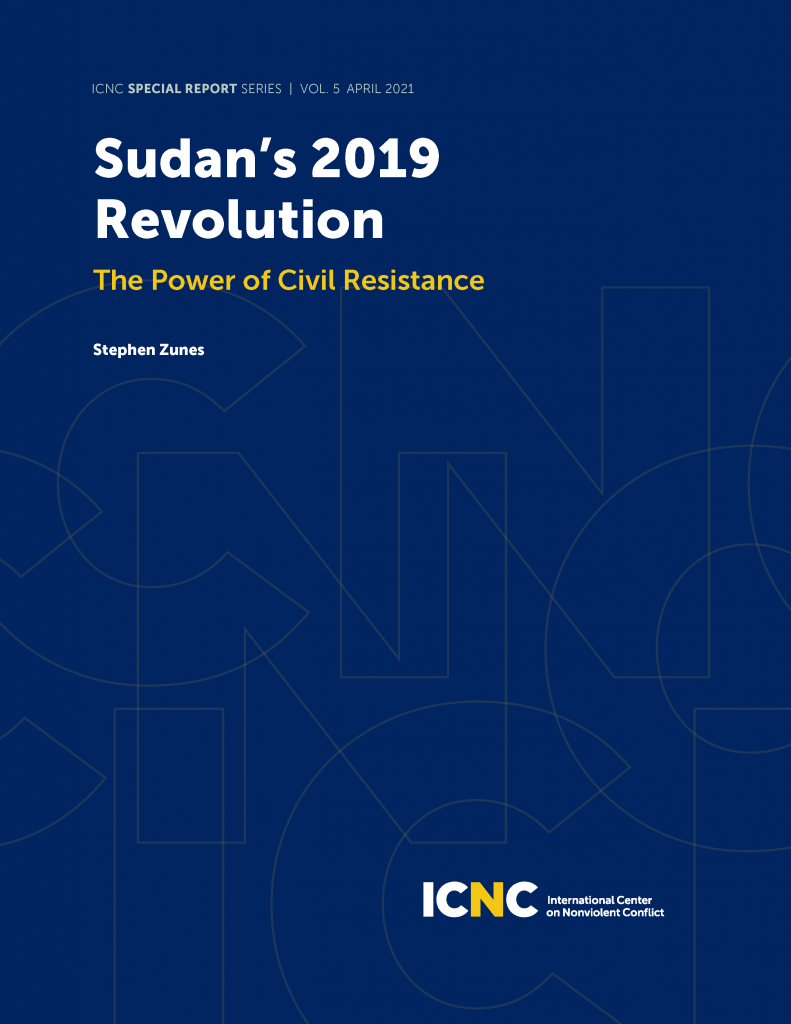
Working Tirelessly for Peace and Equality: Civil Resistance and Peacebuilding in Liberia
By Janel B. Galvanek and James Suah Shilue
Date of Publication: May 2021
Free Download | Purchase a Print Copy
From the establishment of the Liberian state in 1848, the Americo-Liberian settlers—descendants of freed slaves from the USA—imposed a form of indirect rule over the indigenous Liberian population that oppressed, marginalized and exploited the majority of the population. This treatment of the native population became increasingly unsustainable, and in 1980 the settler government was overthrown. A 10-year dictatorship was followed by a violent civil war that lasted until 2003. Using the framework developed by Veronique Dudouet in her 2017 ICNC Special Report, Powering to Peace: Integrating Civil Resistance and Peacebuilding Strategies, this case study examines the methodologies and approaches of the various actors involved in civil resistance and peacebuilding throughout the various phases of conflict in Liberia, from a period of latent conflict to the post-settlement phase after 2003. Many different actors in Liberia pursued strategies of peacebuilding and civil resistance simultaneously, which led to the complementarity of their work and increased the impact they had on both political and civic reform, as well as on the ultimate peace process. The case study takes an in-depth look at the impact that the strategies had on each other in their common pursuit of peace and justice in Liberia.
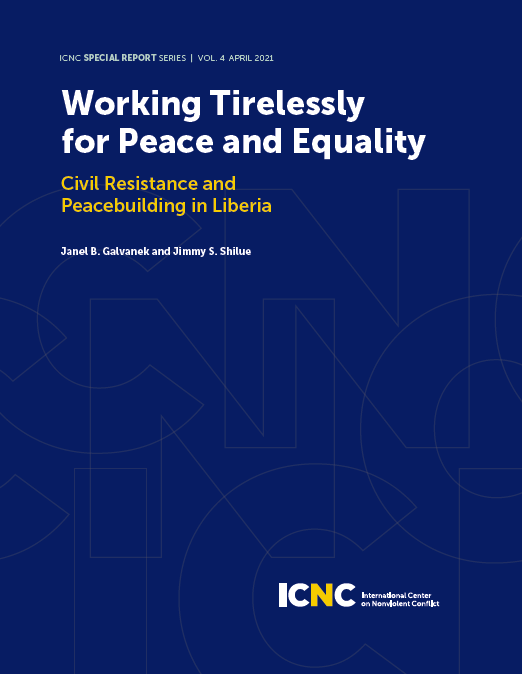
From the Hills to the Streets to the Table: Civil Resistance and Peacebuilding in the Transformation of Nepal’s Maoist Conflict
By: Ches Thurber and Subindra Bogati
Date of Publication: April 2021
Free Download | Purchase a Print Copy
From 1996 until 2006 Nepal experienced a civil war that resulted in an estimated 17,000 casualties. Remarkably, the conflict ended when the Maoist insurgents forged an agreement with the country’s political parties to jointly launch a civil resistance campaign to oust the King. The civil resistance campaign succeeded in overthrowing the King, the former rebels have been integrated into normal democratic politics—even holding the premiership on multiple occasions—and Nepal has not seen a reversion to large-scale violence. However, many of the social tensions that initiated the conflict still have not been resolved. Protests are a regular occurrence and there has been a proliferation of armed groups in Nepal’s southern plains and Western hills. What caused the Maoists to take arms? How were they convinced to transition to civil resistance? What accounts for the success and failures of the subsequent peace process?
We attempt to analyze these questions by utilizing the framework developed by Veronique Dudouet in her 2017 ICNC Special Report, Powering to Peace: Integrating Civil Resistance and Peacebuilding Strategies. We trace the development of conflict from a period of latent conflict with high levels of horizontal inequalities and structural violence to an outbreak of overt, but initially violent conflict. We then illustrate how a transition from civil war to civil resistance was made possible and led to a successful conflict settlement. However, flaws in the conflict settlement process have produced a turbulent post-settlement process, one that falls short of the goals of reconciliation, transitional justice, and sustainable peace.
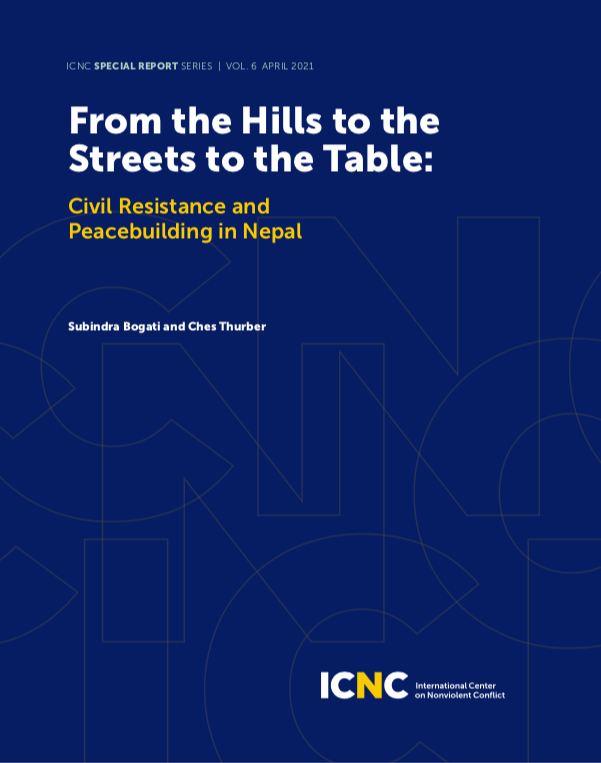
Preventing Mass Atrocities: From a Responsibility to Protect (RtoP) to a Right to Assist (RtoA) Campaigns of Civil Resistance
By Peter Ackerman and Hardy Merriman, May 2019
Free Download: English | Arabic | French | Spanish
Purchase a Print Copy
Events of the last decade demand new approaches to atrocity prevention that are adaptable, innovative and independent of a state-centered doctrine. With the aim of reducing risk factors such as civil war, we argue for a new normative framework called The Right to Assist (RtoA), which could strengthen international coordination and support for nonviolent civil resistance campaigns demanding rights, freedom and justice against non-democratic rule.
RtoA would: 1) engage a wide range of stakeholders such as NGOs, states, multilateral institutions and others; 2) bolster various factors of resilience against state fragility; and 3) incentivize opposition groups to sustain commitment to nonviolent strategies of change. The adoption of this doctrine can reduce the probability of violent conflict that significantly heightens atrocity risk, while increasing the prospects for constructive human development.
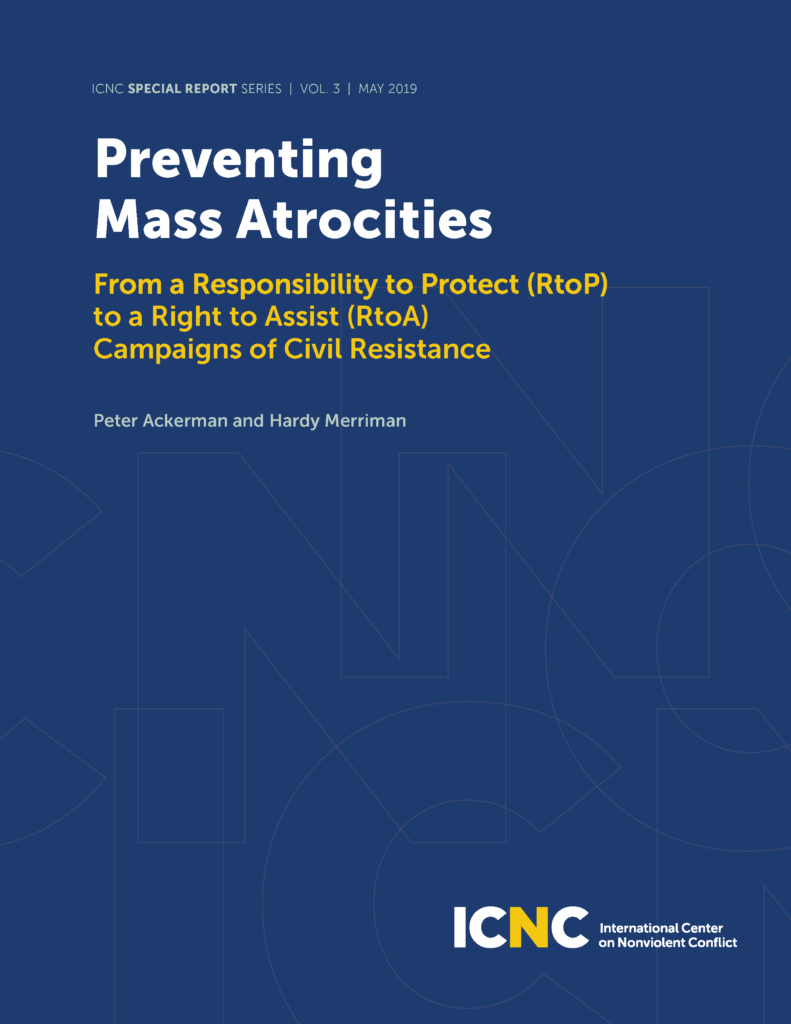
Nonviolent Resistance and Prevention of Mass Killings During Popular Uprisings
By: Erica Chenoweth and Evan Perkoski, April 2018
Free Download | Purchase a Print Copy
What drives governments to crack down on and kill their own civilians? And how—and to what extent—has nonviolent resistance historically mitigated the likelihood of mass killings? This special report explores the factors associated with mass killings: when governments intentionally kill 1,000 or more civilian noncombatants. We find that these events are surprisingly common, occurring in just under half of all maximalist popular uprisings against states, yet they are strongly associated with certain types of resistance. Nonviolent uprisings that do not receive foreign material aid and that manage to gain military defections tend to be the safest. These findings shed light on how both dissidents and their foreign allies can work together to reduce the likelihood of violent confrontations.
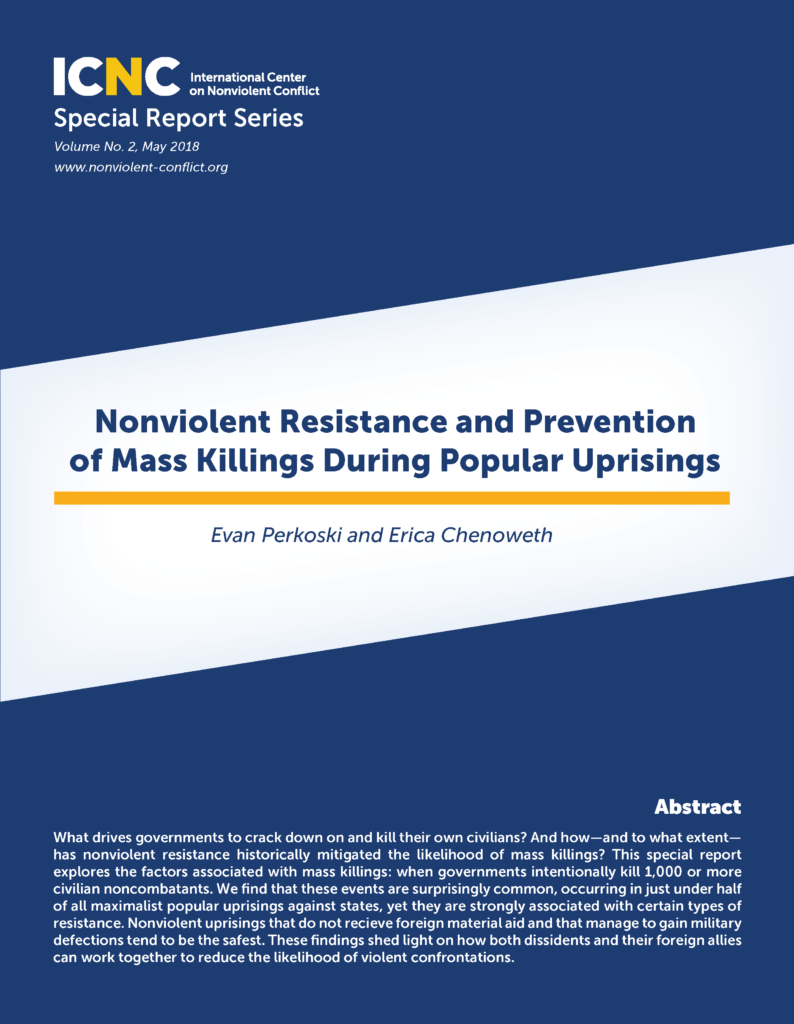
Powering to Peace: Integrated Civil Resistance and Peacebuilding Strategies
By: Véronique Dudouet, April 2017
Free Download | Download French Translation |
Purchase copies: English | French
This report explores the complementary ideas and practices that civil resistance and peacebuilding approaches present, each from different points along the conflict transformation spectrum. Both strategies oppose violence in all its forms, and seek to pursue just peace by peaceful means. However, they take different approaches to conflict transformation, in particular how they analyze primary causes of violence and how they respond to conflict. Drawing on a number of case studies, this report aims to help practitioners and scholars understand how integrating these strategies can help establish a path for “powering to peace.
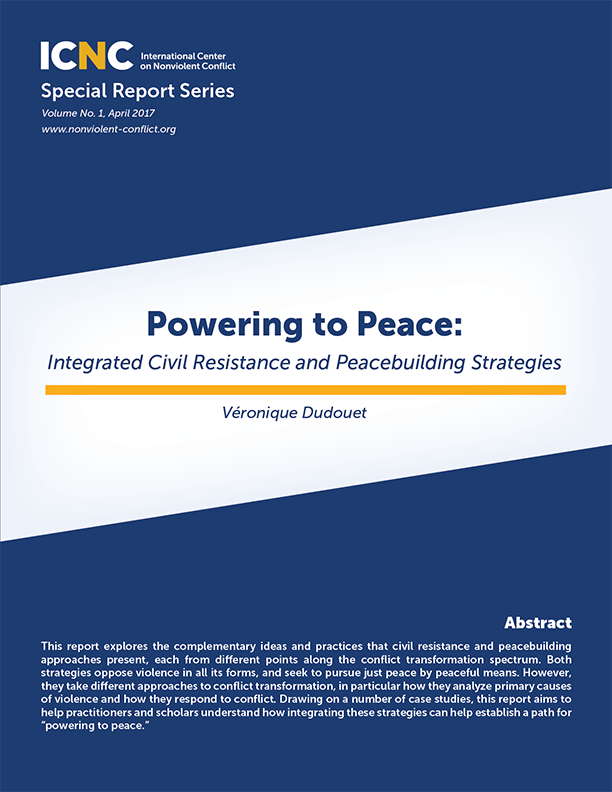
ICNC Monograph Series
ICNC’s Monograph Series aims to enrich public discourse by expanding scientific knowledge. Monographs are designed to be accessible to practitioners, while drawing on scholarly literature and high-quality analytical and empirical research. Each monograph includes general and specific recommendations for practitioners such as activists, organizers, journalists, and members of INGOs and the policy community.
Details on all of our published monographs are here.

The Role of External Support in Nonviolent Campaigns: Poisoned Chalice or Holy Grail?
By: Erica Chenoweth & Maria J. Stephan
Date of Publication: February 2021
Free Download | Purchase a Copy
This monograph draws from an ICNC-sponsored multi-year research project that examines the effects of different forms of external aid on the outcomes and longer-term impacts of civil resistance campaigns. Very little research has systematically investigated the impacts of external support on the effectiveness of nonviolent resistance. Existing research reaches somewhat contradictory conclusions, with some finding that external support for nonviolent campaigns is harmful, that external support is sometimes helpful, or that external support has little observable effect. This study assesses different types of external – material and non-material – assistance to civil resistance movements offered by state ad non-state actors at different stages of civil resistance: pre, during and post-conflict periods. Finally, it evaluates the impact of the specific type of aid, its timing and provisions by different actors on the overall trajectories of civil resistance campaigns and their outcomes.
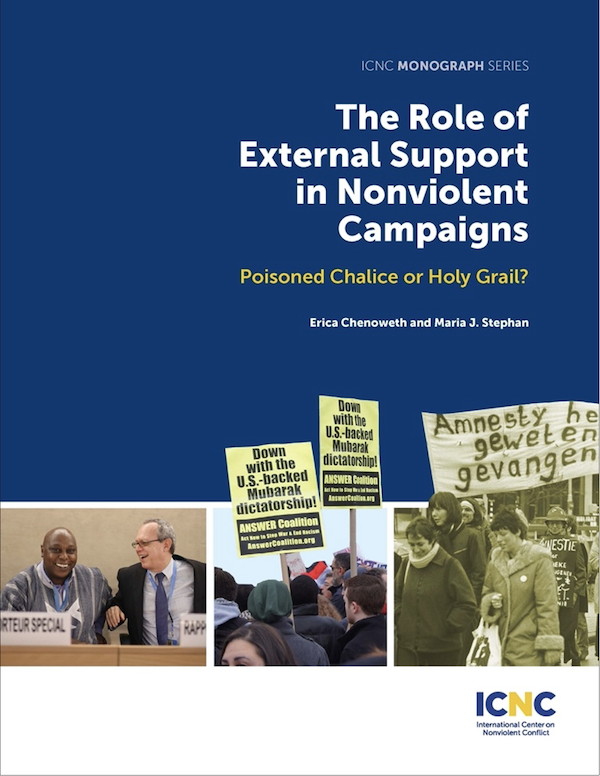
When Civil Resistance Succeeds: Building Democracy After Popular Nonviolent Uprisings
By: Jonathan Pinckney, October 2018
Free Download | Purchase a Print Copy
Why do some nonviolent revolutions lead to successful democratization while others fail to consolidate democratic change? And what can activists do to push toward a victory over dictatorship that results in long-term political freedom?
Several studies show that nonviolent revolutions are generally a more positive force for democratization than violent revolutions and top-down political transitions. However, some nonviolent revolutions, such as the Arab Spring revolution in Egypt, do not seem to fit this pattern. This study takes on this puzzle and reveals that the answer lies in large part in the actions of civil society prior to and during transition. Democracy is most likely when activists can keep their social bases mobilized for positive political change while directing that mobilization toward building new political institutions.
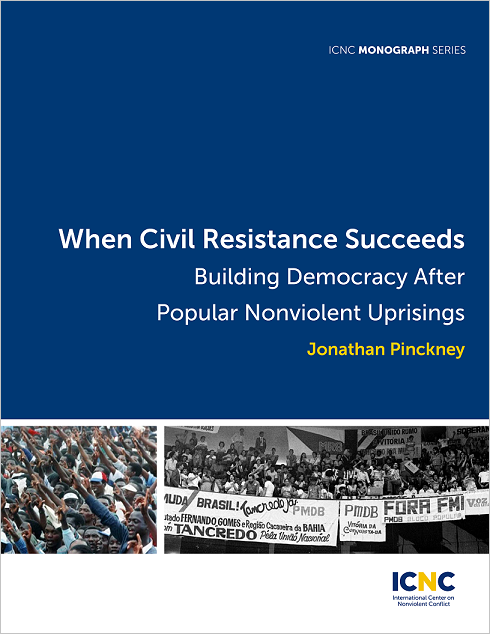
People Power Movements and Civil Resistance: Creating a Legal Framework
By: Elizabeth Wilson
August 2017, Revised July 2019
Free Download | Purchase a Print Copy
International human rights law did not come into existence top-down, out of the benevolent intentions of states, even though states eventually began to recognize that large-scale human rights abuses could pose a threat to the international order. Rather, it came into existence from the bottom-up efforts of ordinary people in civil society to ally with each other in solidarity and demand their rights, often through organized nonviolent campaigns and movements that pressured elites and powerholders to recognize or grant individual rights (freedom for slaves, women’s rights, labor rights, and children’s rights, to name a few). Unlike international law generally, the real source of international human rights law has been the coordinated, organized and nonviolently forceful efforts of individuals—in other words, what one can refer to as people power.
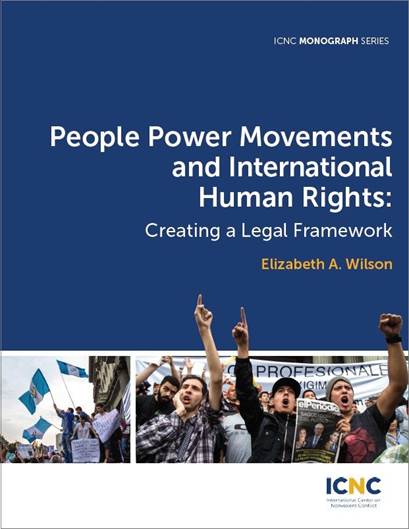
Civil Resistance Against Coups: A Comparative and Historical Perspective
By: Stephen Zunes, December 2017
Free Download: English | Thai
Purchase a Print Copy
This monograph will examine civil resistance against efforts by the military or other elements to forcefully overthrow democratic governments and replace them with autocratic regimes. Using five scenarios of civilian-driven nonviolent counter-coups consisting of two cases each, the monograph will address such questions as: How are such uprisings similar and different than the more protracted pro-democracy struggles against already-existing dictatorships? What is relevant from the existing literature regarding anti-authoritarian civil insurrections and what is unique to counter-coups? How can civil society successfully mobilize large numbers of people in a short time prior to the consolidation of power by undemocratic forces? What potential is there for civil society to organize in advance and plan contingencies for rapid mobilization in the event of a coup? What in particular would be most effective in terms of planning?
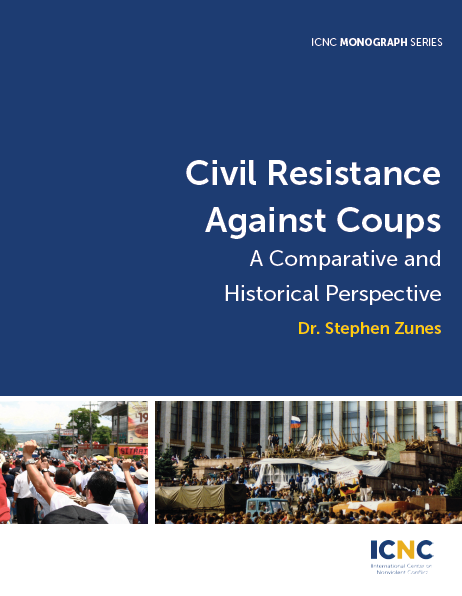
Independently Published ICNC-Supported Research
Civil Resistance and Conflict Transformation: Transitions from Armed to Nonviolent Struggle
This book investigates the decision-making process, rationale and determining factors which underlie the strategic shifts of armed movements from violent to nonviolent resistance. The revival of global interest in the phenomenon of nonviolent struggle since the 2011 Arab Spring offers a welcome opportunity to revisit the potential of unarmed resistance as an alternative pathway out of armed conflicts, in cases where neither military (or counter-insurgency) nor negotiated solutions have succeeded. This volume brings together academics from various disciplinary traditions and offers a wide range of case studies – including South Africa, Palestine and Egypt – through which to view the changes from violence to nonviolence within self-determination, revolutionary or pro-democracy struggles.
See also: ICNC Webinar on “Dynamics and Factors of Transition from Violence to Nonviolent Resistance”, with Veronique Dudouet (November 2014)
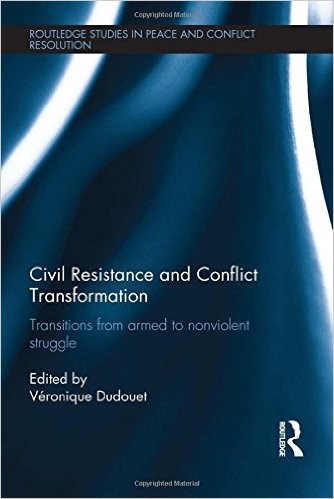
Curtailing Corruption: People Power for Accountability and Justice
How do citizens counter corruption and exact accountability from power holders? What strategic value does people power bring to the anticorruption struggle? Can bottom-up, citizen-based strategies complement and reinforce top-down anticorruption efforts? Addressing these questions—and demonstrating the critical role of grassroots efforts in the anticorruption/ accountability equation—the book explores how millions of people around the world have refused to be victims of corruption and become instead the protagonists of successful nonviolent civic movements to gain accountability and promote positive political, social, and economic change.
Website: curtailingcorruption.org
Download the Book (individual chapters below):
- Chapter 1 — Corruption, People, and Power
- Chapter 2 — Approaches to Curbing Corruption
- Chapter 3 — Blacklisting Corrupt Candidates: Korea
- Chapter 4 — Digital Resistance for Clean Politicians: Brazil
- Chapter 5 — Citizens Protect an Anticorruption Commission: Indonesia
- Chapter 6 — Nonviolent Resistance Against the Mafia: Italy
- Chapter 7 — A Citizen Pillar Against Corruption: India
- Chapter 8 — Community Monitoring for Postwar Transformation: Afghanistan
- Chapter 9 — Curbing Police Corruption Through Engagement and Disruption: Uganda
- Chapter 10 — Highlights from Five Cases: Bosnia-Herzegovina, Egypt, Kenya, Mexico, Turkey
- Chapter 11 — What We Have Learned
- Chapter 12 — The International Dimension
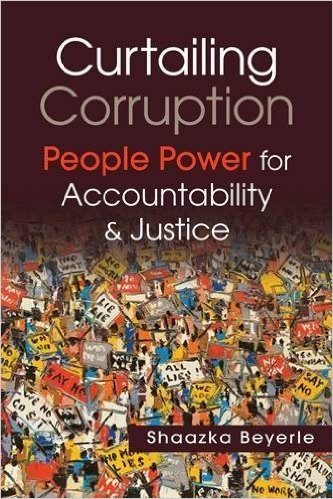
Why Civil Resistance Works: The Strategic Logic of Nonviolent Conflict
Combining statistical analysis with case studies of specific countries and territories, Erica Chenoweth and Maria J. Stephan detail factors enabling nonviolent resistance campaigns to succeed and, sometimes, fail. They find such campaigns present fewer obstacles to moral and physical involvement and commitment, and higher levels of participation contribute to enhanced resilience, greater opportunities for tactical innovation and civic disruption (and therefore less incentive for a regime to maintain its status quo), and shifts in loyalty among opponents’ erstwhile supporters, including members of the military establishment. Chenoweth and Stephan conclude that successful nonviolent resistance ushers in more durable and internally peaceful democracies, which are less likely to regress into civil war. Presenting a rich, evidentiary argument, they originally and systematically compare violent and nonviolent outcomes in different historical periods and geographical contexts, debunking the myth that violence occurs because of structural and environmental factors and that it is necessary to achieve certain political goals. Instead, the authors discover, violent insurgency is rarely justifiable on strategic grounds.
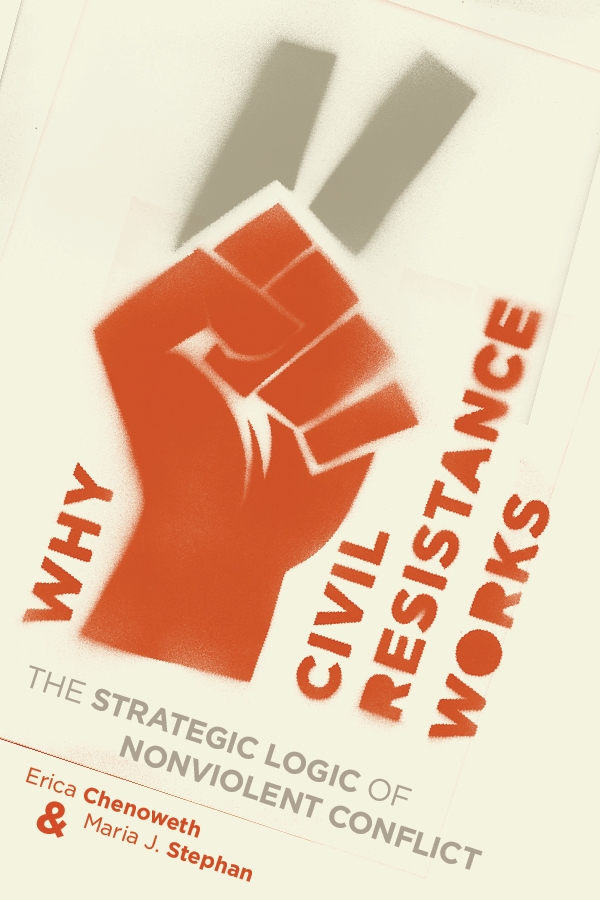
A Diplomat’s Handbook for Democracy Development Support, Second Edition
Responding to requests from civil society and governments, diplomats make important contributions to democratic development. Their work is largely unknown. Outdated stereotypes of this profession persist. The Diplomat’s Handbook begins to tell the diplomat’s story through case studies of practical measures diplomats from many democratic countries have taken across the globe. The Handbook recognizes that democracy cannot be exported or imported. It must be developed by the citizens of the country concerned. There is no one formula for success. But outside assistance is often requested, and there is a dearth of professional material for training and guiding our diplomats in deciding how they can appropriately respond. Civil society as well as governments can benefit from the Handbook, gaining a better understanding of what they can request from diplomats, who in today’s public diplomacy represent their own civil society as well.
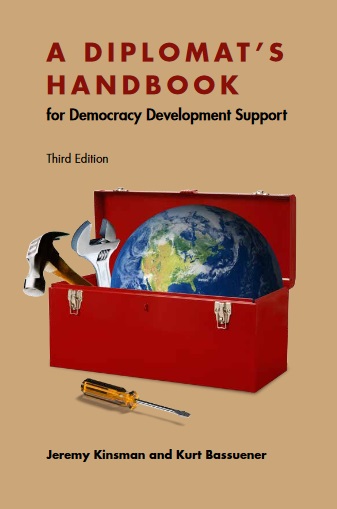
How Freedom is Won: From Civic Resistance to Durable Democracy
The study, How Freedom is Won: From Civic Resistance to Durable Democracy focuses on 67 countries where dictatorships have fallen since 1972. It draws on over 30 years of Freedom House data analyzing the state of global freedom and is the most comprehensive examination of political transitions ever conducted. The report’s central conclusion is that how a transition from authoritarianism occurs and the forces that drive the transition have significant impact on the success or failure of democratic reform. In large measure, the study finds that transitions generated by nonviolent civic coalitions lead to far better results for freedom than top-down transitions initiated by elites. The study finds that “people power” is a frequent phenomenon, and civic coalitions are a major presence in most transitions. In 50 of the 67 transitions, or over 70 percent of countries where authoritarian systems fell, nonviolent civic resistance was a strong influence. Civic resistance employs such tactics as mass protests, boycotts, blockades, strikes, and civil disobedience to challenge the legitimacy of and erode support for authoritarian rulers.
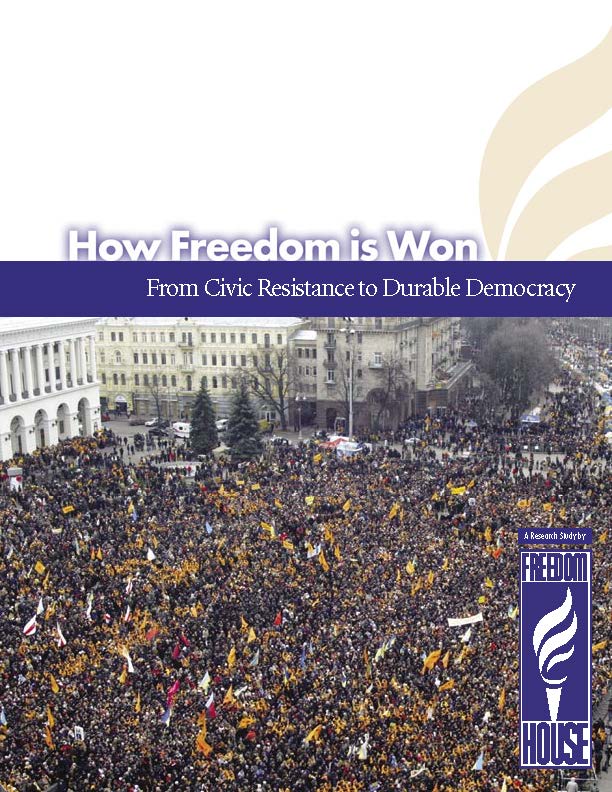
Ongoing Research Projects
The Impact of Nonviolent Resistance on Civil War Resolution (tentative title)
Forthcoming, 2021
Abstract: In recent years, a burgeoning literature has explored the strategic advantages of using nonviolent resistance to achieve positive political outcomes, such as regime change and democratization. Yet, despite one-fifth of large-scale nonviolent campaigns occurring during the course of a civil war, we know little about the affect nonviolent resistance might have on the transformation of armed conflict. Bringing together the previously isolated literatures on nonviolent resistance and peacebuilding, this manuscript explores how nonviolent resistance can aid peacebuilding efforts that transform ongoing armed conflict, using data on all civil wars episodes since 1945. The finding show nonviolent resistance does have a positive impact on the resolution of armed conflict, with evidence deriving from a Large-N statistical analysis, out-of-sample prediction and structured-focused case studies.

The Nonviolent Campaign of the Pashtun Protection Movement in Pakistan
Forthcoming, 2021
Abstract: The Pashtun Protection Movement Pakistan (PTMP) is a youth-led nonviolent resistance campaign for human rights for the Pashtun people in northwestern Pakistan. This movement’s is reminiscent of Pashtun historical icon Bacha Khan’s organizing nonviolent action for justice in Pakistan’s past. How are these young Pashtuns differentiating themselves from violent religious extremists (e.g. Taliban Movement) and resisting government repression and mistreatment through nonviolent resistance activities? How do they develop and use nonviolent strategies and tactics in their protests and actions? How do they engage supporters and opponents of the movement? How do they manage funding and media coverage of their activities? The study seeks to answer these and other questions questions via relevant field research and data collection and is funded by the ICNC as part of its 2018 rapid field data collection grant.

Foundation Support for Pro-Democracy Social Movement Building
Forthcoming, 2021
Abstract: Why and how have some institutional donors in the United States supported nonviolent social movement building in non-democracies?
A number of movement-centric research projects seek to explore the effects of donor support for nonviolent social movements on their success or failure. By contrast, this research is donor-centric. It seeks to understand why and how donors decide to support nonviolent social movement building in the first place. This research will explore a range of factors that might influence donor support for social movement building including donors’ internal structures, donors’ perception of political risk, and the nature of donors’ understanding of and relationships to social movements.
In collaboration with the Human Rights Funders Network, this project will utilize the Advancing Human Rights database to outline trends in donor support from 2011-2015. Interviews with and a comparative case study of donors will allow this project to offer a detailed understanding of how donors work. In doing so, this research seeks to offer insights to donors, academics, and movements, amongst others about the availability of financial and other resources for social movement building in closed and closing political spaces.

ICNC Online Resources
Resource Library
Visit our online Resource Library to find hundreds of resources on civil resistance in over 70 languages. Search resources by keyword or a variety of categories to find material in your language and relevant to your interests. Many resources are downloadable.
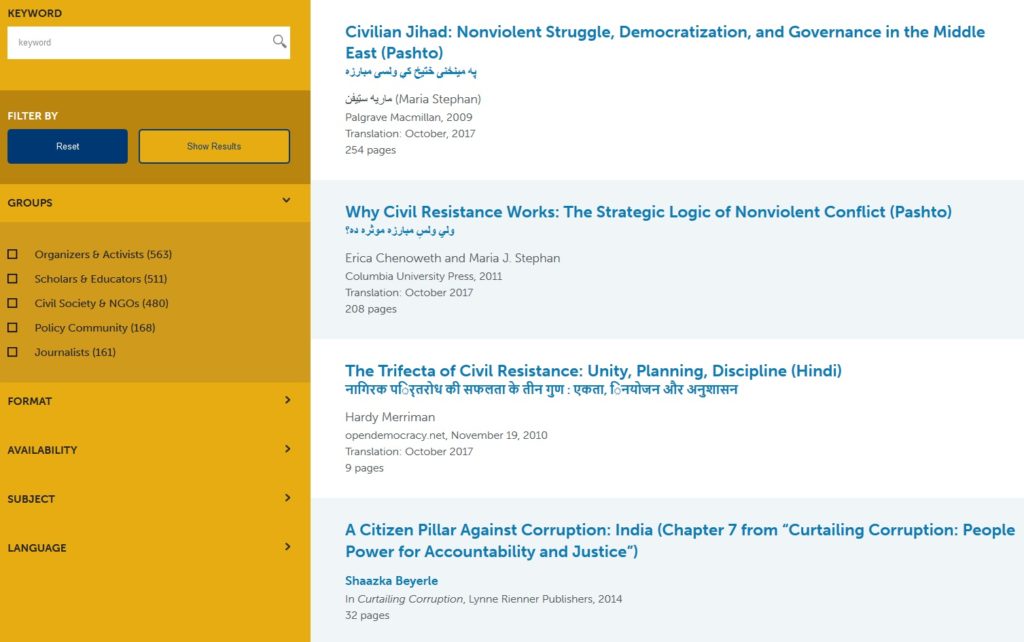
Minds of the Movement
Minds of the Movement (ICNC’s blog) is a forum for a wide range of people interested in the growing field of civil resistance. Our stories, interviews and commentary give readers insight on particular developments, strategies, and movements, highlighting lessons learned and implications.
Some recent blogposts of interest to the policy community include:
Recent Blog Posts:
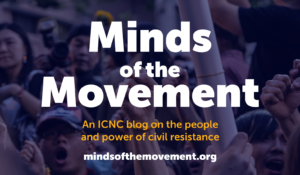
Webinar Presentations
Since 2010, ICNC has offered a webinar series of online talks on critical ideas, cases, and questions related to civil resistance and nonviolent movements. Some recent webinars of interest to the policy community include:
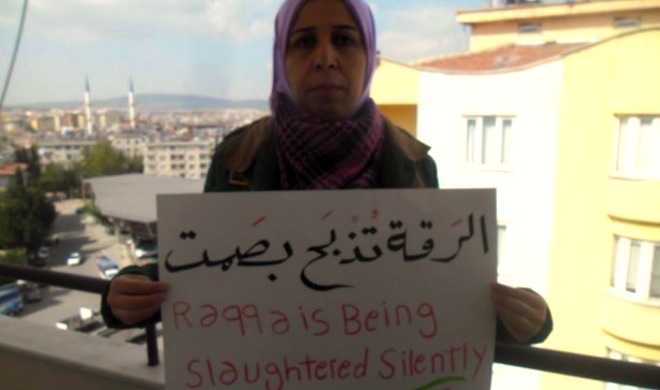
Confronting the Caliphate: Nonviolent Resistance in Jihadist Proto-States
by Isak Svensson, Professor at the Department of Peace and Conflict Research, Uppsala University, Sweden.
This webinar explored how people living in jihadist proto-states organized by groups like ISIS have used civil resistance —including acts of popular disobedience, non-cooperation, protests and public defiance—against such regimes to improve their lives and defend their values.
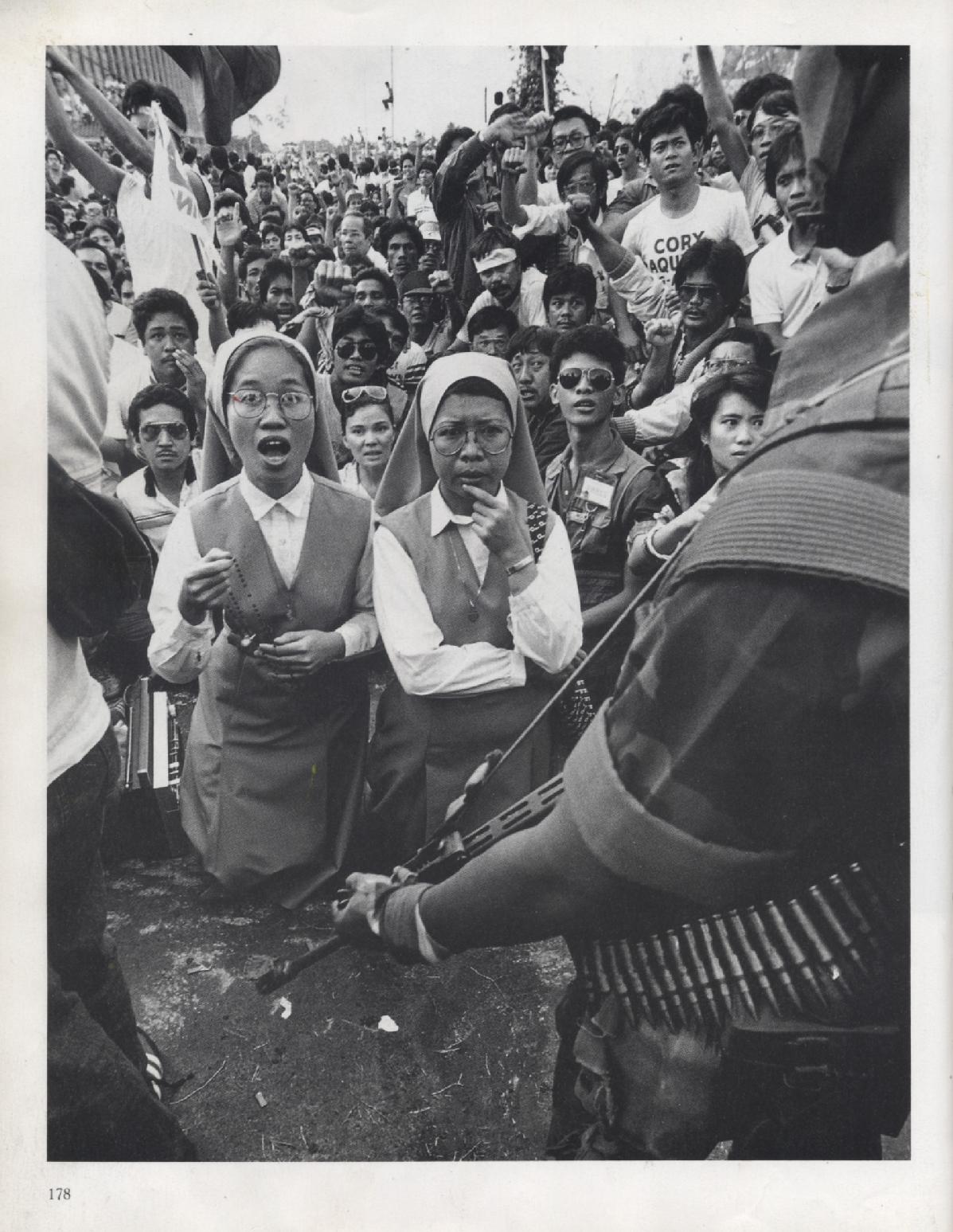
Promoting Civil Resistance as Part of the Catholic Nonviolence Initiative
by Marie Dennis, Sharon Erickson Nepstad, and Eli McCarthy
In this webinar, we heard from a scholar and two members of the Catholic Nonviolence Initiative as they described CNI’s efforts to deepen the Catholic Church’s understanding of and commitment to “active nonviolence” with a particular focus on civil resistance as a key tool in promoting social justice.
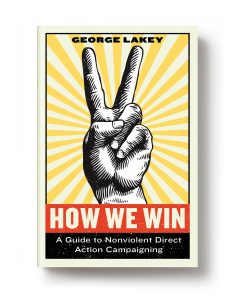
How We Win: Reflections on Nonviolent Direct Action Campaigning
by George Lakey
In this webinar, George Lakey, a long time social movement organizer and the author of How We Win: A Guide to Nonviolent Direct Action Campaigning, shares some of the key lessons he’s learned about how to organize powerful, strategic, and effective movements. The first half of this one hour webinar is an interview with George by ICNC staffer Steve Chase, which is then followed by an engaged Q & A discussion with participants.
We will be updating the list of the upcoming webinars regularly and encourage our readers and viewers to return to this webpage periodically.
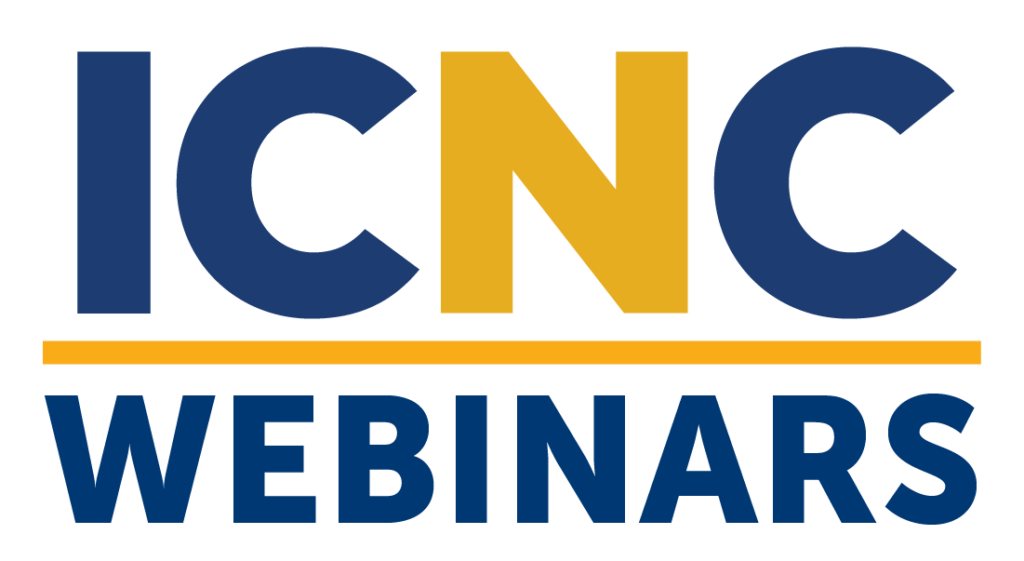
Past Programs
ICNC Summer Institute
 The ICNC Summer Institute for the Advanced Study of Nonviolent Conflict (formerly called the Fletcher Summer Institute) was the first professional education program in the world focusing on the advanced, interdisciplinary study of civil resistance.
The ICNC Summer Institute for the Advanced Study of Nonviolent Conflict (formerly called the Fletcher Summer Institute) was the first professional education program in the world focusing on the advanced, interdisciplinary study of civil resistance.
Organized annually from 2006 to 2016, this 5-6 day course accepted 45-50 international participants—including activists, scholars, journalists, and members of NGOs and the policy community—per year to learn about diverse assets of movement organizing and civil resistance.
In 2017, in response to rising demand for knowledge of civil resistance around the world, ICNC made a strategic decision to discontinue the ICNC Summer Institute and instead to establish ICNC Regional Institutes, which aim to provide increased accessibility and allow more participants to attend. Although the ICNC Summer Institute will not be taking place this year, more information about past Institutes, as well as video-recorded presentations from past years, may be accessed here.
The Nonviolent and Violent Campaigns and Outcomes (NAVCO) Data Project
Principal Investigator: Erica Chenoweth, 2009-2017
The Nonviolent and Violent Campaigns and Outcomes (NAVCO) Data Project is a multi-level data collection effort, to which ICNC contributed intellectually and also served as the primary financial supporter, that catalogues major nonviolent and violent resistance campaigns around the globe from 1900-2011. Researchers can use this data to better answer questions about how tactical choices lead to the success or failure of such political movements, how inter-group relationships among competing insurgent organizations affects their strategic choices, and how the sequencing of tactical choices influence the overall outcomes of resistance campaigns. The project produces:
- aggregate-level data on resistance campaigns from 1900-2006 (NAVCO 1.1)
- annual data on campaign behavior from 1945-2006 (NAVCO 2.0)
- events data on tactical selection during campaigns from 1987-2011 (NAVCO 3.0).
NAVCO 2.0 will be regularly updated with new cases of civil resistance struggles.
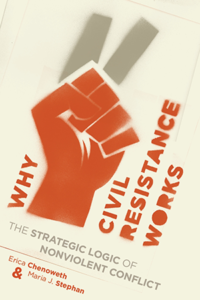 The Nonviolent and Violent Campaign and Outcomes (NAVCO) research project led to the publication of their book titled Why Civil Resistance Works: The Strategic Logic of Civil Resistance, published by Columbia University Press in 2011.
The Nonviolent and Violent Campaign and Outcomes (NAVCO) research project led to the publication of their book titled Why Civil Resistance Works: The Strategic Logic of Civil Resistance, published by Columbia University Press in 2011.
This book, based on ICNC-supported research, won the 2012 Woodrow Wilson Foundation award for “the best book on government, politics, or international affairs”, given by the American Political Science Association. The book also resulted in the authors receiving the 2013 Grawemeyer Award for Ideas Improving World Order.
External Support for Nonviolent Campaigns: Data Collection and Analysis
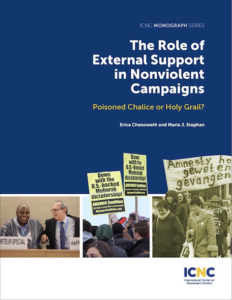 Principal Investigators: Erica Chenoweth, Harvard Kennedy School, and Maria J. Stephan, USIP and Atlantic Council
Principal Investigators: Erica Chenoweth, Harvard Kennedy School, and Maria J. Stephan, USIP and Atlantic Council
ICNC supported research on the effects of different forms of external aid—or combined forms of external aid—on the outcomes and longer-term impacts of civil resistance campaigns. The research team aim collected and analyzed systematic data on numerous nonviolent campaigns to assess their impacts, employing a three-pronged methodology to ensure: (1) data reliability; (2) causal inference; (3) generalizability; and (4) legibility to practitioners. This led to the ICNC publication: The Role of External Support in Nonviolent Campaigns: Poisoned Chalice or Holy Grail?